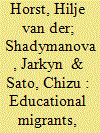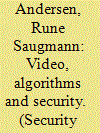| Srl | Item |
| 1 |
ID:
167120


|
|
|
|
|
| Summary/Abstract |
Previous research on transnational migration and information and communication technologies (ICTs) demonstrated how ICTs shape transnational social relationships. What remains less explored is how ICTs shape spatial dimensions of such relationships. Also, international educational migrants constitute a substantial part of transnational migration flow, yet their everyday lives are not well studied. Building upon material semiotic scholarship, we examine how ICTs shape socio-spatial dimensions of transnational relationships in the lives of educational migrants, and the impacts that such relationships have on their everyday lives. This research is based on the empirical exploration of 21 in-depth interviews with educational migrants who came from Central Asian and African countries to the Netherlands. We show that spatial relationships, such as co-presence and distance, are not naturally ‘given’ but are instead enacted in heterogeneous communication practices of educational migrants, and these relationships produce both enabling and constraining effects on their everyday lives.
|
|
|
|
|
|
|
|
|
|
|
|
|
|
|
|
| 2 |
ID:
154750


|
|
|
|
|
| Summary/Abstract |
Digital videos increasingly sustain new and older imagined communities (and enmities), and make battlefields, unfolding terror plots and emergencies public. Yet digital videos mediate security articulations following logics that are radically different from those of journalistically edited media, with consequences for how we should think of security articulation in new visual media. This article analyses how, in digital video, the combination of visible facts and the remediation logics of algorithmically governed video platforms – such as YouTube and Facebook – allow for new types of security articulations. It argues that digital video can be understood as a semiotic composite where the material semiotics of media technologies, calculated publics and spectators combines with the political semiotics of audio-visual media to condition how video articulations work as political agency. A powerful video-mediated security articulation, the #neda videos from the 2009 Iranian post-election crisis, illustrates how security articulation in digital video is not tied to the authority of a speaker and does not contain the promise of an immediate, illocutionary security effect. Drawing on securitization theory and Butler’s critique of speech act theory, this article understands such video articulations as post-sovereign security articulations.
|
|
|
|
|
|
|
|
|
|
|
|
|
|
|
|